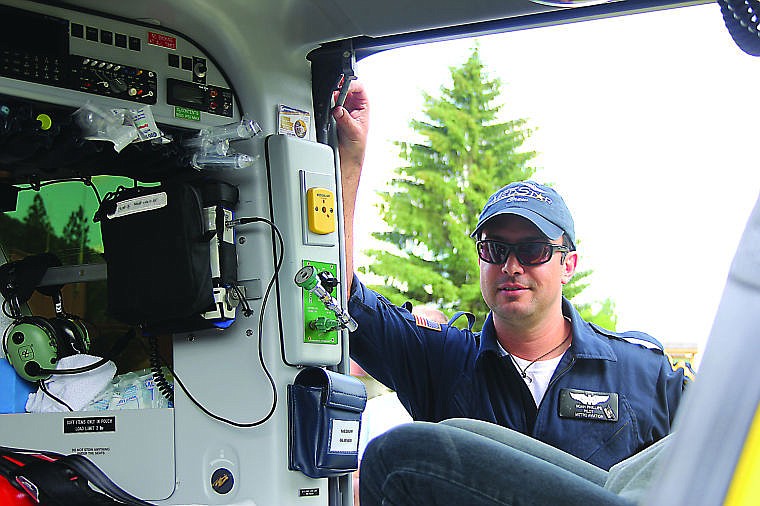Training covers drugs, choppers
SUPERIOR – With an ever-increasing drug problem in the county, Superior’s first responders were educated about different types of prescription drugs and were also given the chance to look over MedStar’s new helicopter.
During the second portion of their monthly training, the ambulance staff along with sheriff’s deputies and health staff listened to a presentation focused on the abuse of prescription drugs.
“We have a fairly big drug problem here,” Angie Coleman said.
Coleman is involved with both the hospital and the Superior ambulance team.
According to Coleman, the community has seen a big spike lately, especially in prescription drug overdoses. She stated the problem starts as early as junior high and the Mineral Community Hospital has seen 14-15 year olds who have overdosed.
“Most of them don’t realize the risks,” Coleman said.
Mark Long, narcotics chief with the Montana Department of Justice, was on hand to give a presentation.
“There is no doubt about it that in Montana and in the nation, the number one drug problem is prescription drugs,” Long said.
The numbers of deaths resulting from the abuse of prescription drugs was more than meth related deaths, traffic deaths and homicides combined.
With staggering numbers, Long aimed to educate the responders on the different types of prescription drugs that were commonly abused.
According to Long, few of the deaths are related from mixing different drugs. Typically overdose deaths result from the improper use of prescription drugs. Abusers commonly take the drugs by snorting them, smoking them or injecting them.
Long described a handful of different drugs and how they are abused, diving into fentanyl, morphine and prescription stimulants among others. He singled out methadone as a drug that has gained a mass popularity in both Montana and the country.
Recently, an increase of methadone related incidents have also been reported in Mineral County.
“What we are finding out is the way methadone works in your body is different from most of the other pain medications,” Long explained.
Methadone will stay in one’s system for up to 60 hours and often times overdoses occur because the users believe they are no longer high, when in fact the medication is still in their system.
“What happens is it tricks you if you are an addict. You get high, you start to not get high, you think it’s out of your system so you hit it again. After one or two or three times, there is enough of that pill to hit toxic levels in your system and it kills you,” Long said.
Virtually all of the deaths related to methadone appear to be accidental, according to Long.
Often times, the eyes hold the answer to what a person is abusing. Those who are using prescription drugs or opiates will experience small, pinpoint like pupils, while those abusing stimulants will have large pupils.
According to Mineral County Sheriff Ernie Ornelas the drug problem in the area has expanded recently.
“The biggest thing is the prescription drugs and that’s why they have classes like this,” Ornelas said.
According to Ornelas, local providers have done their part to help curb the problem, doing more patient monitoring to help ensure drug abuse is limited. The effort, which started approximately three years ago, has seen success.
During the training, the ambulance crew was also able to get up close and personal with some new equipment they may be using in the future.
MedStar brought one of their new helicopters, a Eurocopter EC135, commonly known as an airbus. The company is used at MCH and transports trauma victims to different hospitals when needed.
The biggest difference between the new helicopter is that it provides rear loading, making it faster to load and unload.
“It just makes me plum happy and they can haul two patients eventually,” Coleman said.
The rear-loading feature gives responders more room on the inside.
“It’s quick that way and it has a little more elbow room on the inside to work on them,” MedStar Nurse Larry Peterman said.
The helicopter has twin engines, compared to the one engine helicopter used previously and uses a tail rotor instead of a two-bladed tail system. The blades are enclosed making it safer, however Pilot Noah Phillips said responders still needed to use caution when by the rotor.
The height and weight capacity for a patient is slightly larger with the new copter.
“Genius comes from working within limitations, so this is the envelope,” said Phillips. “We’ll do whatever we can to make it work within there and keep it safe at the same time. Good information helps us make those good decisions.”
MedStar is a company based out of Spokane, although the helicopter shown was housed at the Missoula airport.
Paramedic John Whalen said this time of the year the MedStar crew offers numerous trainings throughout northwestern Montana to first responders.
“During this time of the year we could do like four or five a week of these kinds of trainings,” Whalen said.
The trainings aim to help educate first responders, allowing them to continually expand their knowledge.

